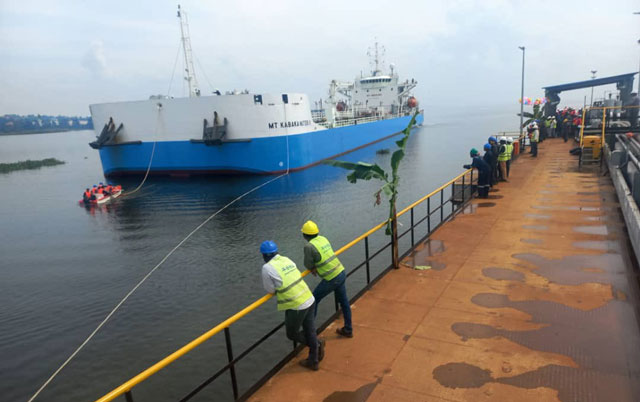
Former Uganda Revenue Authority (URA) Commissioner Customs Dicksons C Kateshumbwa has taken to X (twitter) to weigh the options after President Yoweri Museveni pushed for the country to import fuel directly into the country and not going through Kenyan middlemen. Here is a summary of his thread, titled “Petroleum Supply Bill – Why I cautiously support it”
COMMENT | DICKSONS KATESHUMBWA | On Tuesday, Parliament passed the bill to grant Uganda National Oil Company (UNOC) right to supply fuel into the country. There has been a lot of debate on this, some based on lack of information. As a former Commissioner Customs, am fully aware of the historical dynamics of inbound fuel into EAC over the years.
Fuel is a very sensitive and important commodity in an economy. It drives military operations, air planes, industries, and mobility transportation. Any country’s first strategic focus on fuel is to ensure its availability.
Fuel prices are a function of product cost, transpiration and taxes. Over the years fuel into the EAC was cleared through the OTS (Open Tender System) coordinated by the Ministry in Charge of Petroleum in Kenya. Ugandan participants in the OTS used to pay the nominated Oil Marketing Companies (OMCs) in Kenya to obtain their share of imports into Uganda. The premiums were sometimes as low as 35$ /MT (metric ton).
In March 2023, Kenya ditched the OTS arrangement by entering into a G to G arrangement with Gulf companies to supply all fuel in the region (including Uganda), at very high premiums, eg 118$ per MT for AGO (Automotive Gas Oil) and 97.5$ for PMS (Premium Motor Spirit). They also negotiated a 6-month credit period in which GOK would pay the Gulf companies after supply.
The 6-month period was to ease the current forex challenges in Kenya but our Ugandan OMCs would not be allowed to take advantage, as they would be required to pay upfront for the fuel so dollars would remain in Kenya for 6months. This unilateral decision in my opinion wasn’t made in good spirit. Uganda should have been involved in negotiations. You cannot earn from Uganda’s fuel volumes on high premiums at the disadvantage of Uganda.
President Museveni has made the right decision to try and reverse this disadvantage.
Since we have been ditched, let’s go on our own. Let’s empower UNOC to bring in the fuel. The only challenge is that UNOC is not effectively capitalized. They would need 100m dollars perhaps for starters to order directly from refineries. In the government’s wisdom they looked for Vitol (don’t ask me about the merits or demerits), I focus on the principle.
Vitol or any other supplier will ship the fuel up to Mombasa and pass on the tittle to UNOC, from whom the Ugandan OMCs will buy fuel according to their nominated volumes. Each OMC will pay for their volumes and clear it’s fuel. Usually Uganda consumes about 200m liters of fuel per month. The region has been receiving about 6 fuel ships at Mombasa monthly as regional fuel cargo. Uganda will now receive its 2 ships.
Dynamics at play
Since middlemen have been removed, they are not happy. Will they attempt to frustrate, perhaps not because Uganda is too big to be bullied!
Since UNOC doesn’t own any logistical infrastructure facilities in Kenya to clear the fuel, it has to be pumped at Mombasa and cleared thru the Kenyan Pipeline System (KPC). We therefore must negotiate with Kenya to ensure efficient clearance and flow of our fuel through Mombasa and KPC. Any delays or frustrations will take away the advantage we are trying to achieve.
Kenya is still the most viable route for our fuel so we cannot afford to engage in mega phone diplomacy, but pragmatic dialogue.
Should our private sector OMCs celebrate or not? I think it’s a mixed reaction.
Some may have cash flow challenges. They used to clear six ships so the cash requirements are spread, now they must clear twice. So they have to rearrange their financing mechanisms. Shall we have security of supply, perhaps yes, bse Kenya cannot localize our fuel once it arrives at the port?
But suppose our fuel delays to arrive? How do we mitigate shortage?
Govt thru UNOC must negotiate a fuel stock exchange and replacement mechanism with our neighbors. Our needs can be filled with fuel in the system and it’s reimbursed when ours arrives. Besides, there must be serious regulation and performance measures with the supplier (UNOCs Vitol) to ensure continuous reliability – the margin of error for performance shortages should be close to zero!
The company must stick to the negotiated premiums (which are much lower than Kenya’s) or even aim to reduce them. Ultimately the government should strengthen UNOC and capitalize it to give it capacity to buy fuel directly from refineries. Government also must ensure it strengthens and streamlines regulation.
Currently the down and midstream are regulated by Petroleum Authority of Uganda(PAU), the Upstream by a Department in the Ministry of Energy and MD. In my view we should have one regulator for the entire chain.
UNOC should focus on its role, resource its staff and up its game. The fuel game is tricky, it’s riddled with deep interests. Government taking control in the interest of its people should be hailed, however it must mitigate potential challenges along the way through bilateral engagements with Government of Kenya, experts and private sector.
Following The President H.E @KagutaMuseveni confirmation of having contracted Bulk and Refinery suppliers able to give us fuel at lower prices, I briefed Her Excellency @SuluhuSamia Uganda’s proposed new policy on bulk importation and supply of Petroleum products to Uganda. pic.twitter.com/6j0wxwJ1Es
— Ruth Nankabirwa Ssentamu (@NankabirwaRS) November 6, 2023
The Dar es salaam option
Over the years Dar in Tanzania has made significant investments in expansion of port infrastructure to facilitate regional trade. For the case of fuel imports to Uganda, Dar is not a sole option but a supplementary option.
The distance from Dar es Salam to Mutukula is about 1500km. The cost of transportation per cubic meter from Dar to Uanda is about 120-130$. There is no pipeline from Dar to Uganda for now so transportation is by road and partly through lake via Mwanza.
This road transport journey on average takes the truck an average 5-6 days. On the other hand, via Mombasa route fuel is pumped through KPC to western Kenya , that is to Eldoret, Nakuru, Kisumu. From there Ugandan OMCs evacuate to Kampala via a distance of 300 Kms at a cost of 40$ per Cubic Meter. This route is therefore much more viable and cost effective. But as a country we need both routes and we have to keep pushing for improved efficiency at both ports as well as minimize logistical costs. Future regional developments like the pipeline via Tanga, will change the dynamics and lessen the Tanzania route option.
Suffice to note that Rwanda, Burundi, Zambia and DRC clear their fuel largely via Dar route bse its cost effective logistics wise despite some efficiency (delays) challenges along.
In conclusion, we need both ports. They are all necessary. One is not an exclusive substitute of the other. As critical users of the ports who sustain them through our business, we must continuously advocate for their efficiency and lower turnaround times. Japanese ports in 2021 recorded the highest turnaround times of 8 hours, India 22 hrs while our regional ports boast of 75 hours. In business, time is money or rather expense, which is a component in the determination of final consumer price.
*****
 Dicksons C Kateshumbwa is a former Uganda Revenue Authority Commissioner Customs. On X @Kateshd
Dicksons C Kateshumbwa is a former Uganda Revenue Authority Commissioner Customs. On X @Kateshd
 The Independent Uganda: You get the Truth we Pay the Price
The Independent Uganda: You get the Truth we Pay the Price



When will we start to refine our oil.
Your grammar is awful. The way you write doesn’t come up as someone who attended university education.